July 18, 2004
Six Mile Creek Monitoring training
Yesterday morning I enjoyed a workshop for volunteers preparing to monitor Six Mile Creek. They've had several previous sessions and meetings. This one was about "Sample Collection, Chemical Analysis, and Flow." It started at the Bethel Grove Community Center (actually in the playground, as an aerobics class was in the building) and then moved to the bridge on German Cross Road that crosses Six Mile Creek.
There were two complementary aspects to the training: chemistry and geology. Dr. Steve Penningroth of the Community Science Institute explained the chemistry end of things, collecting water samples and testing them to see what's in the water.
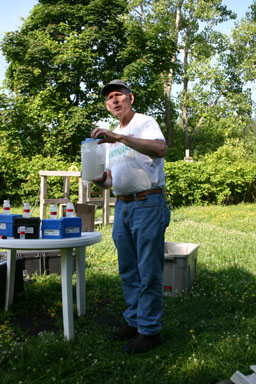
Steve Penningroth shows volunteers collection bottles.
Volunteers will be collecting water from the stream and recording the water temperature. The water can be tested for pH, conductivity, alkalinity (a measure of buffering capacity that isn't just the inverse of pH), hardness, chloride, turbidity, solids, suspended solids, soluble phosphorous, total phosphorous, nitrates, nitrogen, dissolved oxygen, and coliform bacteria. The handout (966 KB PDF) Penningroth provided contains much more detail, including examples of measurements at times of high and low water.
Dr. Dan Karig, Professor Emeritus of Earth and Atmospheric Sciences at Cornell, explained the geological aspects of monitoring, focusing on determining the amount of water flowing down a stream at any given time and how those flows changed the stream and its surroundings. Again, the handout (391KB PDF) has a lot more detail about how this is done.
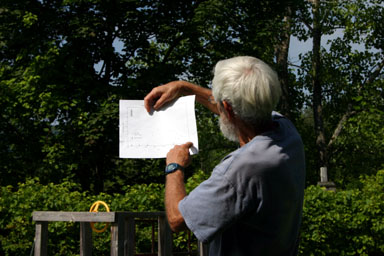
Dan Karig shows a chart of the depth of Six Mile Creek measured at the German Cross Road bridge.
Karig explained that Six Mile Creek is "strongly degrading" - meaning that the creek was cutting into its banks, not that it was full of toxins. The creek is still adjusting from the changes over the past to centuries from forest to agriculture and back again, and hasn't reached an equilibrium. 25,000 cubic yards of sediment currently flow down the creek annually, and land in the City of Ithaca's reservoir system.
After the broad introduction, the class moved to the creek itself to learn about the tests and how to conduct them. Karig demonstrated how to collect data for a stream cross-section and then collect information about the water velocity using a missile-like device.
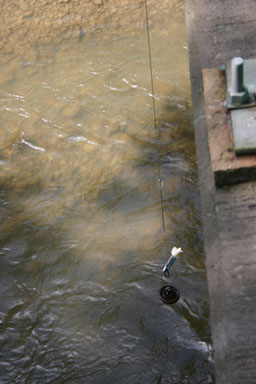
Lowering the velocity tester into Six Mile Creek at the German Cross Road bridge.
Karig also demonstrated a device for collecting water to to determine its sediment content. This heavy device is lowered into the main channel and lowered and raised through the depth. Once brought to the surface, its contents can be analyzed to determine how much sediment is in the water.
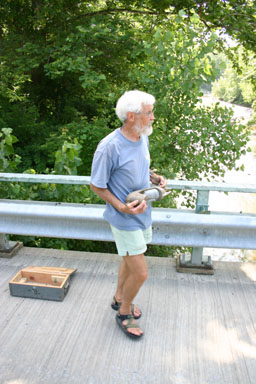
A suspended sediment tester for collecting samples in the creek.
After working with sampling techniques from the bridge, the group went down to the creek to collect samples and work with the test kits.
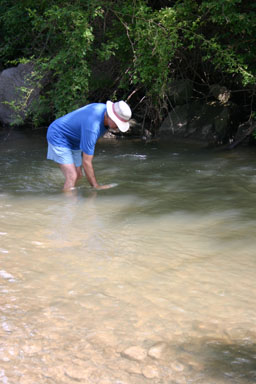
A volunteer gathers water samples in Six Mile Creek.
Once the samples were gathered, Dr. Penningroth showed the group pH testing with a (misbehaving) electronic meter, and then walked them through tests for dissolved oxygen and alkalinity. (The group may or may not use the test kits, which both take a lot of time and have a substantial margin of error, as CSI has a testing lab located here, at Langmuir Lab on Brown Road near the airport.)
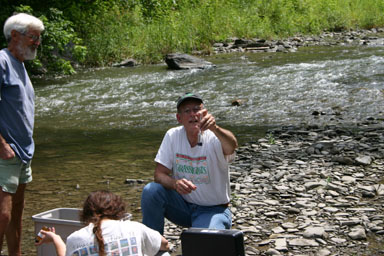
Dr. Penningroth titrates a sample to determine its alkalinity
The volunteers stayed interested, and had plenty of questions. Two people from the Tompkins County Soil & Water Conservation District were also there: Craig Schutt, District Manager, and Gordie Morgan, Conservation Technician. (Schutt is also the Acting Chair of the Town of Dryden Conservation Board, and Karig is a member.)
If you'd like to see more of this event, I've put up my pictures as a gallery.
Posted by simon at July 18, 2004 1:06 PM in Bethel Grove , natural areas , photos , water and sewerNote on photos
hi simon, nice article! i've been working with this group for about 3 years and there's also a biological part of it -
checking on the critters that
live under the rocks.
Am trying to contact Carol Karig through Dan....I too am a nordic skier here in Australia.
Carol was my bridesmaid back in 1965.
Would appreciate any information Dan, if you have time.
Cheers,
Robin Hall (Campbell)